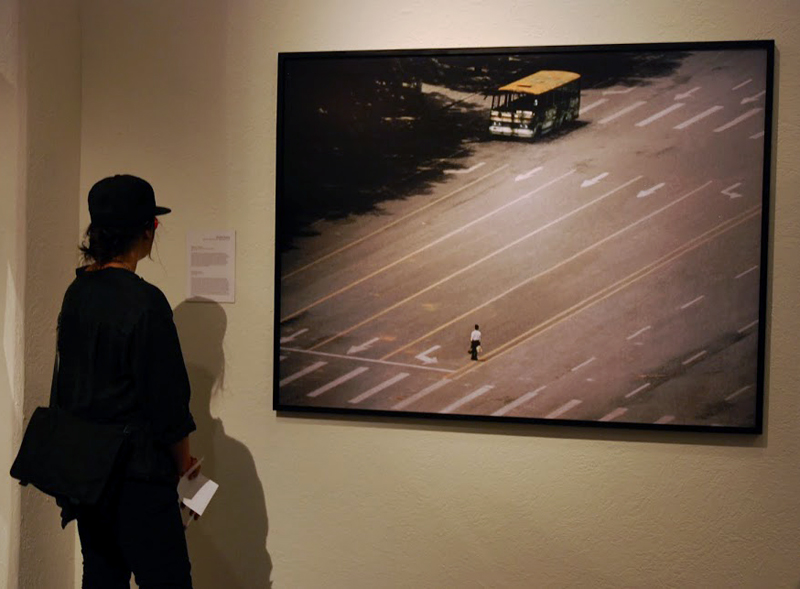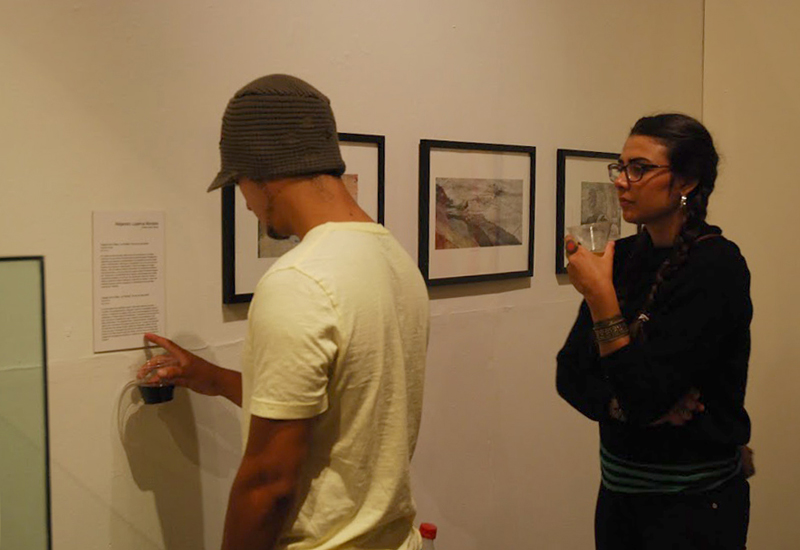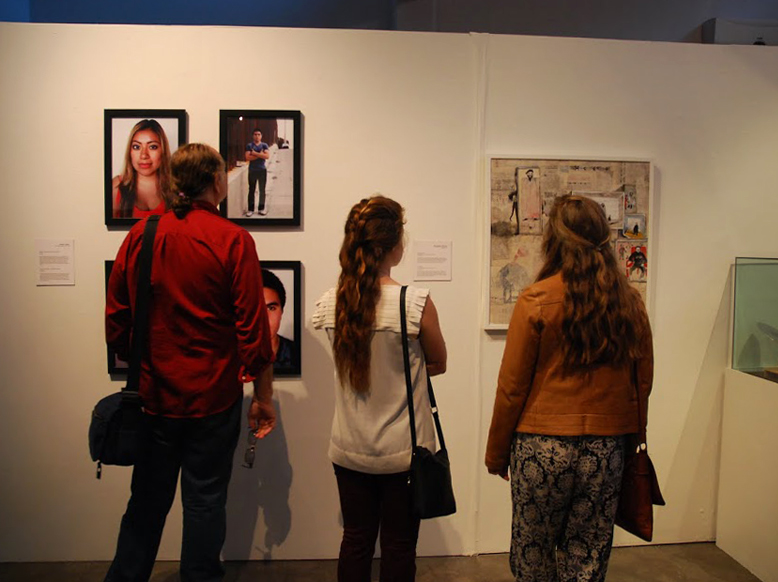Review: Cruzando Fronteras
A look back at the Cruzando Fronteras opening and exhibition | Tijuana, Mexico

On June 13th, Emergent Art space presented Cruzando Fronteras at the Galeria de la Ciudad, in Tijuana, Mexico. The show (up until August 4th) highlights the work of eight artists from Tijuana – San Diego alongside the original Crossing Borders collection. The resulting exhibition is a rich cross-cultural conversation. The Mexican-US border inspired several works, and the crowd at the opening merged people from both sides. Many thanks to the fantastic team at the Galeria de la Ciudad, and to the Instituto Municipal de Arte y Cultura for hosting the show!
Cruzando Fronteras is the second international exhibition promoted by Emergent Art Space. This second show started with the very simple, yet challenging idea of taking the original Crossing Borders, which in June 2013 presented at SOMArts, in San Francisco, works by young artists from 20 different countries, literally across the border from California to Tijuana, Mexico.
The US / Mexican border at San Ysidro is the busiest land-border in the world, with thousands of people crossing it in both directions every day. Tijuana, San Diego and their satellite cities form one of the largest international conurbations of the planet, home to more than 5 million people. It encompasses two countries with unequal median incomes and levels of development. Thousands of people migrate every year to Tijuana from Southern Mexico and Central America, in the hope of crossing the border to the US. Most often they remain in Tijuana, and find low paying jobs at the hundreds of factories which have sprung up around the city since the 1994 Nafta trade agreement between Mexico and the US. Sprawling across both sides of the border, this metropolis represents a huge diversity of cultures, socioeconomics, and opportunities. The vibrance and tension associated with this significant border, a liminal space characterized by both inequality and future promise, made Tijuana a poignant destination for the Crossing Borders exhibition.

After a long gestation, and thanks to the great support we found in Tijuana, this idea of yet another border crossing came alive. Cruzando Fornteras opened on June 13th at the Galeria de la Ciudad.
The inauguration of the exhibition was itself an example of international merging. Around 7:00 p.m. a large group of people gathered in the patio of the building, listening to the opening speeches while waiting to enter the gallery. Many of them, coming from San Diego, had crossed the border to participate in the event, and the mixed crowd mingled in a festive mood.
Once inside the gallery, the diversity and richness of the exhibition came to life as we strolled around the Galeria’s beautiful space. The collaged photograph of Ann Le, a Vietnamese American artist, reminiscing on the long and perilous voyage of her family across Malaysia and the South Pacific, stands alongside “Journey of African women,” a small oil by Kabat Ayub, from Kampala, Uganda; on the same wall hangs the bright colored painting by Isha, from Nagpur, India, who dreams of flying across the continents on her paper planes. A large boat made of lace by Heidi Cramer, from California, also sharing a dreamlike quality and suggesting voyages into the unknown, hangs from the ceiling, while on the wall behind it a giant reproduction of the iconic 1989 Tienamen Square picture, minus the tanks, stands in silence (work by Dmitri Zurita).

Sydney Lowe’s photographs of African Italian youth are mirrored, across the hall, by those of Mexican American youth (photos by Jillian Grant), both groups speaking of mixed identities in a changing world. They are joined by the photographs of Shahrzad Ahrhar, an Iranian American artist based in Los Angeles, whose works problematize the mixed identities and difficult choices faced today by young Muslim women: Western or Eastern ways?
Borders are geographical, but also physical. Musing on the boundaries of our physical bodies takes different forms and directions in the oil on canvas by Terezia Greskowa, a Slovenian painter, the mixed media work by Guillermo Echeveste, from Tijuana, and a short video by Lindsey Allgood, a performance artist from Oklahoma.
Closer to the reality of the city are several works by local artists who joined the exhibition with projects specifically addressing this US / Mexico border. Mayte Escobar, Alyssa Hutton, Daniel Pena, among others, grew up here, with families and relatives on both sides, crossing the border back and forth as a natural part of life, belonging to both countries and dealing with both identities, and their works are about the border experience: “There is a constant push and pull between the two countries, the two cultures;” Mayte says when interviewed during the evening, “to me it means being more than one, being two, being part of both.” Mayte’s work is a mesmerizing video of walking along and across, walking on different, yet analogous, paths. Daniel Pena photographed and recorded the sounds of street musicians in San Diego, Tijuana, and Mexico City; by clicking on a small digital sound player you can in turn listen to each of them, and become aware of cultural influences, differences as well as similarities.

Alejandro Morales’ prints stand out, dramatic, speaking of death by the border, the narco traffic, its violence and its victims; on two machetes, enclosed in a plexiglas cabinet, are engraved the silhouettes of the two sides of the violence, a drug lord and a policeman. A powerful reminder of the dark side of the border.
This exhibition commands full attention, aesthetically and morally. There isn’t much small talk happening here, with people walking around with a wine glass in the hand. People are engaged, watching the works, reading the information labels, taking it all in. The event is about reaching out, and connecting. The artists who are present are happy to talk about their works, to share their experiences. “Borders are definitely dividers” says Jillian Grant, “but they also signify all the connections: San Diego, Tijuana, Nogales, Sonora county, is kind of one city, although made of many communities, and my work is about bridging these communities.”
Dmitri Zurita, in his opening speech, summed it up for everybody in just a few powerful words: “We are conscious of our responsibilities (as young artists,) among which is the dissemination of art across borders to promote spaces of peaceful coexistence, friendship, and tolerance.”
Life at the border provides a profound challenge to our imaginations and aspirations. The artwork, perhaps more than any other medium, has the ability to speak to our communal desire to encompass differences.

Many thanks to the Jurors who selected the works by the Tijuana-San Diego artists: Jaime Cuanalo, director of the Escuela Superior de Arte visuals, Playas de Tijuana, and Ricardo Dominguez, art professor at the university of California, San Diego.
Read more about the Cruzando Fronteras exhibtion here.